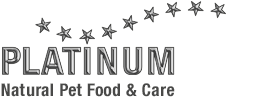
Body language
Dogs don’t feel the same variety of emotions as humans, but they are able to feel joy, sadness, fear and aggression.
The dog - like the wolf - primary uses its body language to communicate with fellows, to express its emotions and to peacefully solve conflicts - so it doesn’t end in a fight every time.
The precedence in a wolf pack can be determined by the rod. The higher the rod is carried, the bigger is the self-confidence of the wolf and its rank in the pack. The position of the dog’s rod also shows a lot. The rod offers the biggest range to show the dog’s mood. The dog is able to wag it from one side to the other and this shows its general joy or excitement. Dominance or aggression puts the rod upwards while insecurity, humbleness and fear lowers or pinches the rod between the legs.
The distinctive body language of the dog can be easily read by the human, if certain signals are observed.
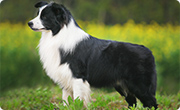
Completely calm
Whilst a calm and normal body position the dog is standing straight and relaxed. The rod is - depending on the breed - carried in the normal position. The whole musculature and face expressions are relaxed and in harmony. The ears are moving loose, equal to moving and sounds.
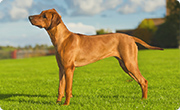
Fully attentive
The dog is in eager expectation for an upcoming adventure. It is standing straight, but relaxed and is focussing a distinct situation or its counterpart. The ears are set up loosely, the lips are opened slightly and the rod is carried horizontal. The dog is self-confident but there is no sign of aggression, like snarl, raised hackles or an aggressive facial expression.
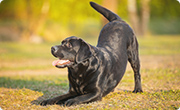
In the mood to play
This dog is inviting its counterpart for a play. In the expectation to play, it is staying in this position or jerky jumping back and forth until the play starts. The forelegs are bent and the torso is almost on the ground. The eyes are focussed and the ears are straightened up attentively. The mouth is slightly opened and with lifted corners of the mouth, so you could assume the dog’s smiling. The rod is lifted and wagging back and forth. Also the dog is inviting its owner with an excited bark to finally throw the ball or play with it.
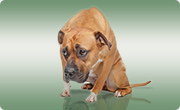
Not up to a fight
The dog is frightened and wants to show its submission or discomfort with this posture. It is pinching the rod between its legs, ducking down, bending back and knees or even crouching down on the ground, making itself as small as possible. The dog doesn’t want to anger the enemy and any kind of aggression is avoided. It is clearly showing its humbleness or fear to the enemy.
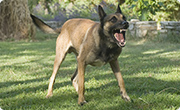
Pretty dominant
A threat is not only expressed by snarl or bark, the dog is also showing teeth, standing motionless, stiff looking and focussing the enemy. In addition, its rod is lifted and the posture is as stretched as possible and broad-shouldered so the dog appears taller. Depending on the intensity of dominance, the dog might snap at the other human or dog. The dog’s intention is to get the opponent to back off. Everyone that has seen a dog in aggression or threat knows that this is very daunting and terrifying.
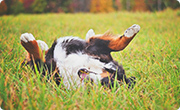
Quite intuitive
A dog rolling back and forth on its back can have various reasons. On the one hand, dogs are rolling on the ground because of joy and well-being. In doing so, they are able to release their excessive energy. On the other hand, dogs tend to lie down and roll on heavy smelling substances to cover their body odour. This arises from the dog’s primary instincts, where it had to hunt the food itself. It enabled the dog to get close to the prey without getting noticed by the smell.
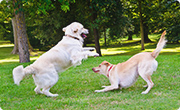
Innocent play or serious fight?
When dogs are tussling, it’s not always clear if they are just playing or if it is a serious dispute. Puppies already learn to play-fight with their siblings. The situation maybe isn’t that obvious in adulthood. But the body language will give you the answer: two playing dogs have a relaxed posture and tussle joyfully. In addition, face and eyes are completely relaxed and the dogs have a friendly eye contact. Aggressions would raise hackles and the posture would be strained and stiff while the dogs watch each other carefully.
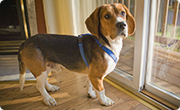
Entirely insecure
The dog is not able to completely assess the situation or is insecure on how to behave. The dog then cocks or ducks its head, flattens its ears but still keeps eye contact to the counterpart. The rod hangs down and overall the dog shows itself defensive, reluctant and submissive.
Not only the human is able to misinterpret the dog’s body language, even among dogs misunderstandings in communication can happen. Some breeds aren’t always understood precisely by their fellows because of the changed appearance. Exemplary causes are the length of their coat (always raised hackle) and the position of ears and rod.
But at the same time, the human’s posture also can be misunderstood by the dog and then results in wrong conclusions. An unknown human, that is bending over from above at the first sight is noticed as extremely dominant. This can be daunting for the dog or even cause a defensive reaction. It is advantageous to hunker down, so you don’t step up to the dog from above but from the front.
Also starring at a dog can evoke or boost aggressions. If you are standing in front of an angry dog, keep standing calm and turn your face and look away slightly, so the dog doesn’t get provoked.
Watch your dog’s body language: what does it want to tell you? The body language reveals you the feelings and concerns and helps you to understand your dog. A better communication also strengthens the relationship between dog and human.
